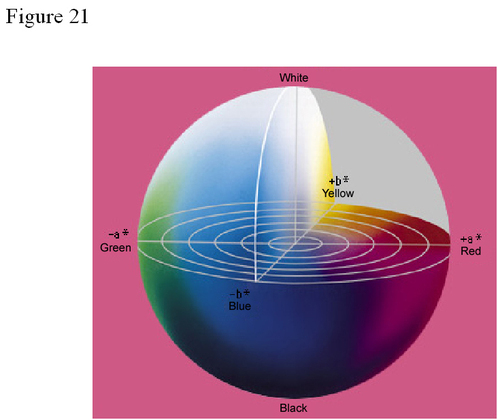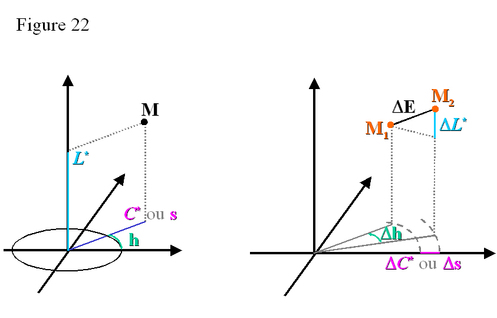
Color differences
The parameters L*u*v* (or L*a*b*) of the CIELUV (CIELAB) color spaces may be represented on 3 orthogonal axes. The case of the CIELAB space is shown in figure 21.

In these color spaces, a colored stimulus may be specified either by its cartesian coordinates L*u*v* (or L*a*b*) or by its cylindrical coordinates (see figure 22) :
-
The hue angle h (h=0° for the red hue and +a* (or +u*) direction ; h=90° pour the yellow hue and +b* (or +v*) direction; h=180° for the green hue and -a* (or -u*) direction; h=270° for the blue hue and -b* (or -v*) direction.)
-
The chroma
 or saturation s (iso-chroma lines
or saturation s (iso-chroma lines
 (or
(or
 ) are concentric circles centered at the origin a*=b*=0 (or u*=v*=0) corresponding to the white reference stimulus).
) are concentric circles centered at the origin a*=b*=0 (or u*=v*=0) corresponding to the white reference stimulus).
-
The lightness L* (défined in § I.C.3.a).

From figure 22, and given two stimuli M1 and M2 having coordinates in the CIELUV (CIELAB) system L*u*v* (L*a*b*, respectively), the differences
 ,
,
 ,
,
 ,
,
 and
and
 are defined by the following relations (see table 3):
are defined by the following relations (see table 3):

The color difference
 between the two stimuli can be thought of as being composed of a difference of lightness
between the two stimuli can be thought of as being composed of a difference of lightness
 , a difference in chroma
, a difference in chroma
 and a difference in hue
and a difference in hue
 .
.
In the graphic arts and printing industry, the maximum acceptable color difference in the CIELAB space is:
-
 =1,5 for most demanding works (reproduction of works of art...),
=1,5 for most demanding works (reproduction of works of art...), -
 =2,0 for magazines,
=2,0 for magazines, -
 =2,5 for newspapers.
=2,5 for newspapers.